
5 May 2025
Clinical Supervision Notes Template & Resources
Effective clinical practice relies on clear documentation and structured reflection. Supervision notes support professional growth, enhance patient care, and ensure ethical compliance when used effectively. They become indispensable tools for tracking progress and refining clinical skills.
This blog will dive into the transformative power of mastering your clinical supervision notes. By understanding and effectively using these notes, you can take control of your clinical practice, streamline your workflow, and elevate the quality of your care. Let’s get started on this empowering journey.
Understanding Clinical Supervision Notes
Supervision notes are simple documentation that provides a structured framework for reflection, accountability, and professional growth.
By mastering the art of creating impactful supervision notes, healthcare professionals can elevate the quality of care, foster professional development, and maintain ethical integrity.
Why Are Supervision Notes Vital in Clinical Practice?
Supervision notes serve a dual purpose: they document key discussions and provide actionable insights to enhance your practice.
- Clarity in Communication: They capture essential session details, ensuring nothing important is overlooked.
- Informed Decision-Making: A well-documented note offers guidance during complex cases or ethical dilemmas.
- Stronger Collaboration: Supervisors gain clear insights into progress and challenges, enabling tailored guidance.
By bridging the gap between reflection and action, supervision notes help transform challenges into opportunities for improvement.
Supporting Professional Growth and Learning
Think of supervision notes as a mirror for your clinical journey. They reflect your strengths, highlight areas for improvement, and provide a roadmap for growth. When used effectively, they become an inspiring tool for continuous professional development.
- Track Your Growth: Record milestones in your learning and practice to objectively assess your progress.
- Refine Your Approach: Use supervisor feedback to enhance your methods and adapt to new challenges.
- Stay Ahead: Integrate emerging techniques and insights into your clinical repertoire.
You’re investing in your growth as a practitioner by consistently reviewing and building upon these notes.
The Ethical Backbone of Healthcare
Ethical dilemmas are inevitable in clinical practice, but supervision notes can provide clarity and confidence. They record the ethical considerations discussed, ensuring your decisions are well-grounded, transparent, and aligned with professional standards, fostering a sense of reassurance and confidence.
- Document Ethical Choices: Maintain a record of actions and their justifications to support integrity and compliance.
- Foster Reflection: Use your notes to examine patterns in your approach and align with ethical frameworks.
- Build Accountability: Stay aligned with professional standards and demonstrate adherence to best practices.
Now that we understand why supervision notes are integral to clinical practice, let’s explore their key components and discover what makes them effective.
Key Components of Supervision Notes

Supervision notes are potent tools that blend professionalism with personal growth. When structured effectively, they capture the essence of each session and guide future improvements. Let’s break down the key components that make your notes impactful and engaging.
Start with a Clear Structure
Every great supervision note begins with a strong foundation. Keep it simple, professional, and easy to reference:
- Patient Information: To ensure confidentiality, use identifiers like initials, session dates, or case numbers.
- Session Highlights: Summarise the key topics discussed, challenges addressed, and milestones achieved.
- Actionable Outcomes: Conclude with clear next steps, decisions made, or tasks to follow up on.
A well-structured note keeps you organised and saves time when reviewing past sessions.
Details about the supervisee, session, and format.
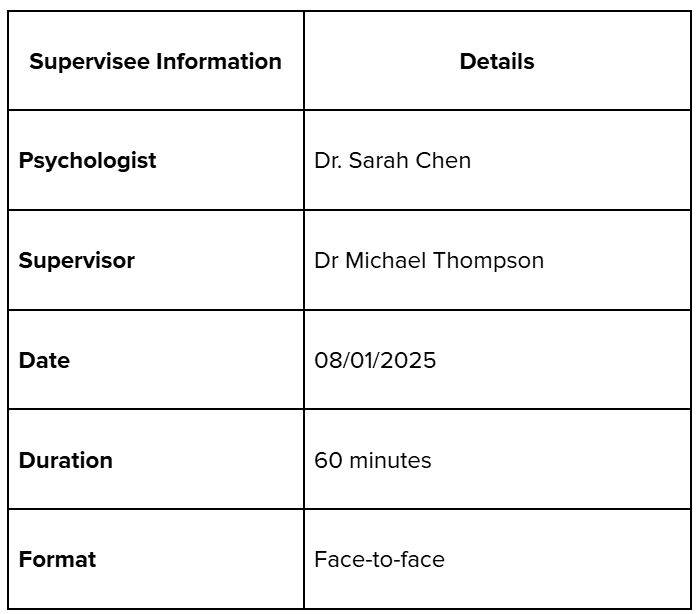
Key details about the case being discussed.
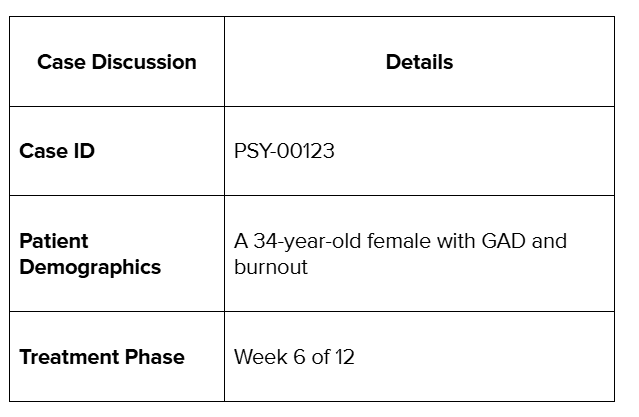
Focus areas discussed during the session.
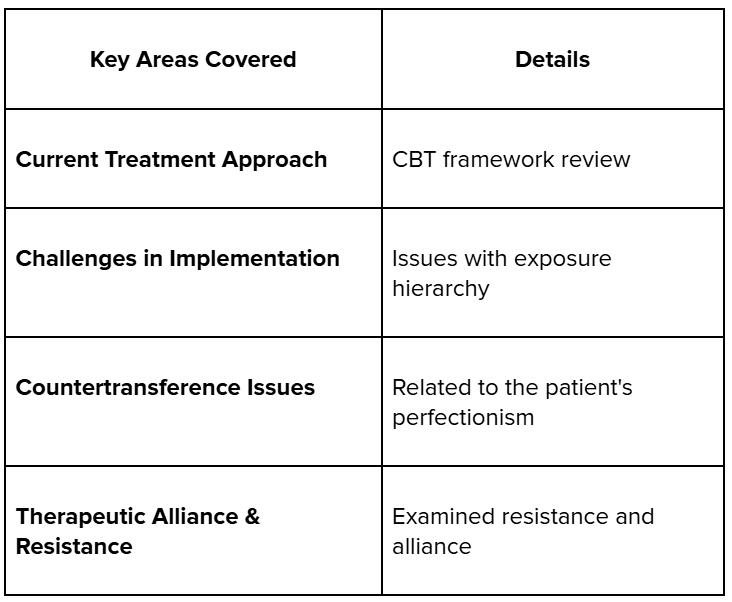
Suggested actions for further treatment and research.
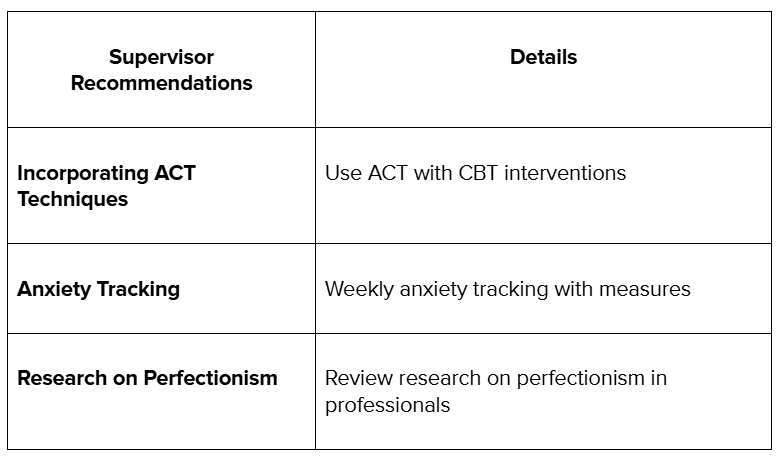
2. Document Feedback and Ethical Considerations
Supervision is a collaborative process. Capturing feedback and ethical discussions ensures your notes are both practical and reflective. Include:
- Supervisor’s Input: Jot down specific guidance or areas for improvement.
- Ethical Discussions: Note any ethical dilemmas and how they were addressed.
- Next Steps: Write down your actions based on the session’s recommendations.
These insights turn your notes into a resource for continuous learning and professional accountability.
3. Balance Facts with Personal Insights
Supervision notes should go beyond just the facts. Incorporate your reflections to add depth and make them more meaningful:
- Objective Data: Capture measurable outcomes, observed behaviours, or specific incidents.
- Personal Reflections: Reflect on what you learned, encountered challenges, or approaches you’d like to try.
This balance creates a note that records and inspires growth and improvement.
By combining structure, feedback, and thoughtful reflection, your supervision notes become much more than documentation—they become a tool for progress.
With the core components of supervision notes in place, let’s explore how to create them effectively and ensure they serve as a practical tool for documentation and development.
Creating Effective Supervision Notes
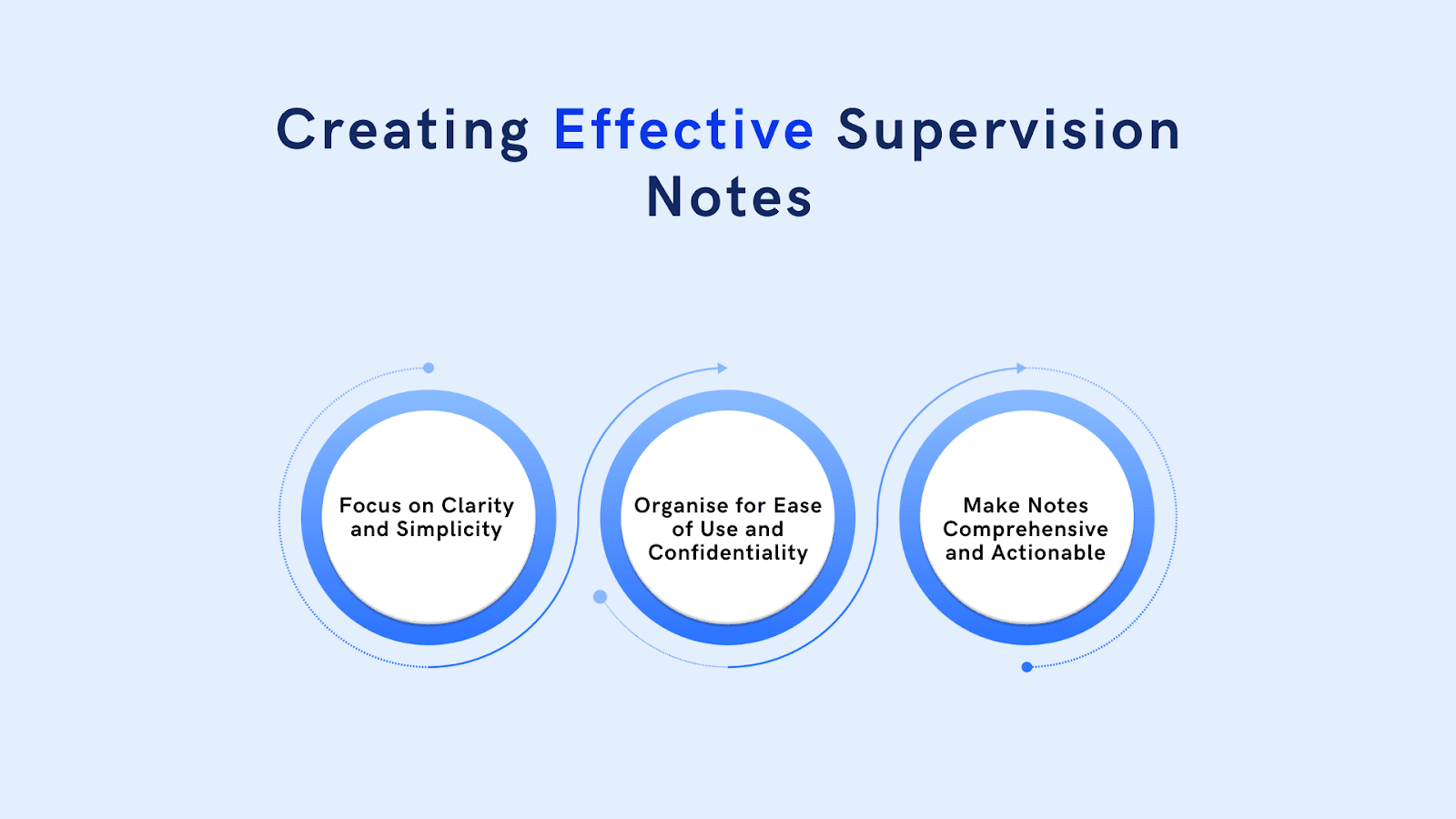
Writing supervision notes isn’t just about keeping records—it’s about creating a tool that supports professional growth and accountability. Here’s how to ensure your notes are impactful, organised, and purposeful.
1. Focus on Clarity and Simplicity
Practical notes are easy to understand and provide a clear session picture. Achieve this by:
- Using a Consistent Format: Adopt a structured layout to keep your notes uniform and straightforward.
- Eliminating Unnecessary Details: Include only what’s relevant to the session’s objectives and outcomes.
- Using Professional Language: Avoid overly technical jargon to maintain readability.
Concise and clear notes make it easier to reference key information and ensure consistency.
2. Organise for Ease of Use and Confidentiality
Proper organisation transforms supervision notes from static records to valuable resources. Keep them secure and accessible by:
- Maintaining Logical Order: Arrange notes chronologically for effortless tracking of progress.
- Highlighting Key Takeaways: Use bullet points, bold text, or headings to emphasise essential insights.
- Securing Sensitive Information: Store notes in encrypted systems or confidential files to ensure privacy.
Organised notes improve workflow and reinforce trust in your documentation practices.
3. Make Notes Comprehensive and Actionable
Supervision notes should capture the essence of each session while providing direction for future actions. Here’s how to keep them effective:
- Prepare Ahead of Time: Outline session goals and expected discussions beforehand.
- Document in Real-Time: Record observations during sessions to capture authentic insights.
- Review and Refine Post-Session: Clarify and complete your notes after the session.
With effective note-taking strategies in mind, let’s explore how templates can simplify the process and elevate the quality of your supervision notes.
Utilising Templates for Supervision Notes
Supervision note templates are powerful tools for healthcare professionals. They provide structure, save time, and ensure your documentation remains consistent and comprehensive. Let’s explore how templates can streamline your process and improve your clinical practice.
1. Why Do Templates Matter?
Templates offer more than just a pre-designed format—they bring clarity and efficiency to note-taking. Key benefits include:
- Standardisation: A uniform layout ensures all necessary details are captured without omissions.
- Time Efficiency: Templates reduce the time spent structuring notes, allowing you to focus on the content.
- Improved Readability: Organised sections make notes more straightforward to review and reference.
By leveraging templates, you can keep your focus on meaningful content while maintaining professional standards.
2. Examples of Effective Templates
Different supervision contexts call for various types of templates. Here are a few widely used examples:
- Clinical Supervision Templates: Include patient updates, challenges, and supervisor feedback sections.
- Social Work Templates: Focus on case details, interventions, and ethical considerations.
- Reflective Practice Templates: Emphasise personal insights and areas for growth alongside session summaries.
These templates are adaptable to suit various clinical disciplines, ensuring you can customise them to fit your needs.
3. How Templates Enhance Supervision Notes
Templates are not just about saving time—they elevate the quality of your notes. They help you:
- Organise Session Details: Predefined sections for patient progress, themes, and feedback keep your notes structured.
- Highlight Key Insights: Templates encourage you to focus on critical takeaways rather than extraneous details.
- Ensure Comprehensive Coverage: With a template, no essential aspect of the session goes undocumented.
Let’s explore how these notes can catalyse growth, feedback integration, and effective treatment planning.
Enhancing Clinical Practice Through Supervision Notes
Supervision notes are more than a record—they’re a tool for refining your clinical skills and decision-making. Using them effectively allows healthcare professionals to transform their documentation into a roadmap for better outcomes and continuous growth.
- Identifying Areas for Growth and ImprovementSupervision notes help you track your clinical journey and uncover patterns in your practice. Reviewing them can highlight recurring challenges, patient progress trends, and areas for additional training or resources.
- Integrating Supervisor Feedback Into PracticeDocumenting supervisor feedback allows you to implement changes, monitor their effectiveness, and align your professional development with clear, actionable insights. Turning feedback into practice strengthens your clinical skills.
- Supporting Case Conceptualisation and Treatment PlanningSupervision notes serve as a reference for patient discussions, helping to refine treatment plans, clarify progress, and ensure alignment with clinical and ethical guidelines for effective decision-making.
While supervision notes enhance your clinical practice, they also present unique challenges requiring careful consideration; let’s examine navigating these challenges while maintaining practical and ethical documentation.
Challenges and Considerations in Note-Taking
While supervision notes are vital to clinical practice, creating them effectively presents challenges. Balancing thorough documentation with engagement during sessions, ensuring cultural sensitivity, and maintaining confidentiality are all critical aspects that require thoughtful attention.
- Balancing Note-Taking and Engagement During SessionsTaking notes during supervision should not disrupt the conversation. Focus on active listening first, use abbreviations for quick documentation, and summarise key takeaways at the end to ensure clarity.
- Respecting Cultural Sensitivity and Maintaining ConfidentialityNotes should be objective, free from bias, and protect patient privacy. Avoid judgmental language, use anonymised identifiers, and ensure compliance with legal and ethical standards.
- Strategies for Effective Record-Keeping and OrganisationWell-organised notes enhance their value. Use secure digital tools, maintain a structured filing system, and review notes periodically to refine insights and track progress.
FAQs About Clinical Supervision Notes
1. What are clinical supervision notes?
A: Clinical supervision notes are structured records of discussions, feedback, and action points from supervision sessions. They help healthcare professionals track progress, ensure accountability, and enhance reflective practice for continuous professional development.
2. Why are supervision notes important in clinical practice?
A: Supervision notes document critical insights, ethical considerations, and actionable feedback. They ensure clarity and compliance with industry standards and support improved patient care through informed decision-making and structured guidance.
3. What should be included in supervision notes?
A: Effective supervision notes include patient information (anonymised), session highlights, supervisor feedback, ethical considerations, and actionable steps. Combining factual details with reflective insights creates a comprehensive record.
4. How can templates improve supervision note-taking?
A: Templates provide a consistent structure, making organising information easier and saving time. They ensure all necessary details are included, improving the quality and readability of supervision notes.
5. How do supervision notes help with professional growth?
A: Supervision notes allow practitioners to reflect on their practice, identify areas for improvement, and track progress over time. By integrating feedback and documenting strategies, they foster continuous learning and development.
6. How can I maintain confidentiality in supervision notes?
A: Use anonymised identifiers for patients and avoid sharing sensitive details. Store notes securely using encrypted digital tools or locked physical files to ensure compliance with privacy regulations.
Conclusion: Elevate Your Clinical Practice with Supervision Notes
Supervision notes are far more than a professional obligation—they are a gateway to personal growth, ethical alignment, and improved patient care. By understanding their purpose, structuring them effectively, leveraging templates, and addressing common challenges, you can turn your notes into a powerful tool for reflective practice and continuous development.
Supervision notes document your clinical journey and enhance your ability to deliver compassionate and effective care when used strategically.
Take the Next Step with Practaluma
At Practaluma, we understand the importance of documentation in driving excellence in clinical practice. That’s why we offer tailored services to help healthcare professionals like you optimise your workflows and achieve better outcomes.
- Explore Our Digital Solutions: Simplify supervision documentation with secure and user-friendly tools.
- Professional Training Services: Learn best practices for creating impactful supervision notes through workshops and resources.
- Customisable Templates: Access templates designed for clinicians to streamline your note-taking process.
Let us help you turn your supervision notes into a strategic asset for growth and success.
Are you ready to advance your clinical practice? Contact Practaluma today to learn how we can help you achieve your professional goals.